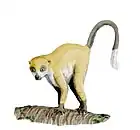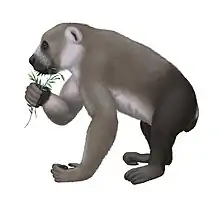Marcgodinotius
Marcgodinotius is a genus of adapiform primate that lived in Asia during the early Eocene.[2][3] It is a monotypic genus, the only species being Marcgodinotius indicus.[2] Another adapiform primate Suratius robustus was found in the same horizon.[4] Anthrasimias may be a junior synonym of Marcgodinotius and Anthrasimias gujaratensis a junior synonym of Marcgodinotius indicus.[5][6]
| Marcgodinotius Temporal range: Early Eocene[1] | |
|---|---|
| Scientific classification | |
| Domain: | Eukaryota |
| Kingdom: | Animalia |
| Phylum: | Chordata |
| Class: | Mammalia |
| Order: | Primates |
| Suborder: | Strepsirrhini |
| Family: | †Notharctidae |
| Genus: | †Marcgodinotius Bajpai et al., 2005 |
| Species: | †M. indicus |
| Binomial name | |
| †Marcgodinotius indicus Bajpai et al., 2005 | |
Marcgodinotius indicus was a species of primate first found in Gujarat, India in 2005. It is believed to have lived about 55 million years ago, during the early Eocene. It weighed around 75 grams which would make it only slightly larger than the world's smallest primates, the mouse lemurs and the dwarf galagos.[7]
The generic name, Anthrasimias, referred to anthra, Greek for coal, because the fossils were found in a coal mine and simias, Latin for monkey or ape.[7]
References
- "PBDB". paleobiodb.org. Retrieved 2021-08-18.
- Bajpai, Sunil; Kapur, Vivesh V.; Thewissen, J. G. M.; Das, Debasis P.; Tiwari, B. N.; Sharma, Ritu; Saravanan, N. (2005). "Early eocene primates from Vastan lignite mine, Gujarat, western India". Journal of the Palaeontological Society of India. 50 (2): 43–45. ISSN 0552-9360.
- Fleagle 2013, pp. 237–238.
- Bajpai, Sunil; Kapur, Vivesh V.; Das, Debasis P.; Tiwari, B. N. (2007). "New early eocene primate (Mammalia) from Vastan lignite Mine, District Surat (Gujarat), western India". Journal of the Palaeontological Society of India. 52 (2): 231–234. ISSN 0552-9360.
- Dunn, Rachel H. (2016). "New euprimate postcrania from the early Eocene of Gujarat, India, and the strepsirrhine–haplorhine divergence". Journal of Human Evolution. 99: 25–51. doi:10.1016/j.jhevol.2016.06.006. PMID 27650579.
- "Twenty-five little bones tell a puzzling story about early primate evolution: Newly discovered primate bones appear to be the most primitive ever found". ScienceDaily. Retrieved 21 February 2019.
- Bajpai, Sunil; et al. (2008). "The oldest Asian record of Anthropoidea" (PDF). Proceedings of the National Academy of Sciences. 105 (32): 11093–11098. Bibcode:2008PNAS..10511093B. doi:10.1073/pnas.0804159105. PMC 2516236. PMID 18685095. Retrieved 2008-08-08.
External links
Literature cited
- Fleagle, J.G. (2013). Primate Adaptation and Evolution (3rd ed.). Academic Press. ISBN 978-0-123-78633-3. OCLC 820107187.

